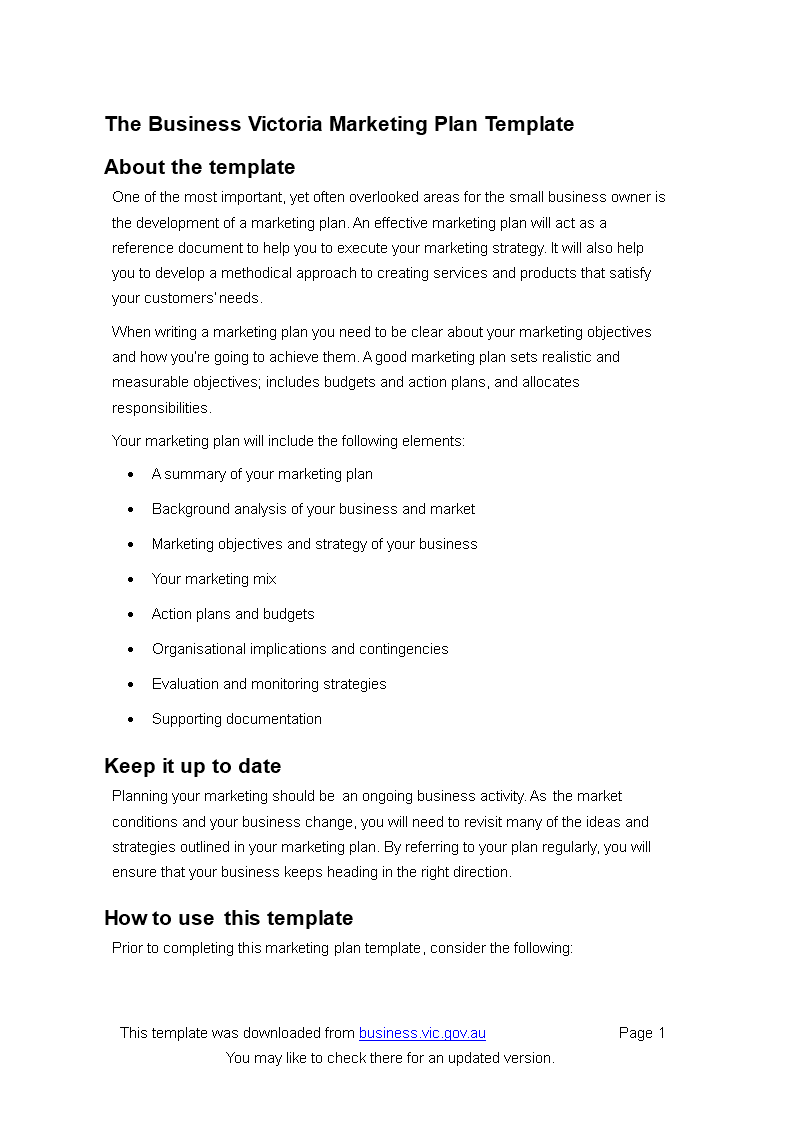Business Marketing Plan Template
Save, fill-In The Blanks, Print, Done!

Download Business Marketing Plan Template
Microsoft Word (.docx)Or select the format you want and we convert it for you for free:
- This Document Has Been Certified by a Professional
- 100% customizable
- This is a digital download (140.2 kB)
- Language: English
- We recommend downloading this file onto your computer.
How to write a marketing plan for a Company? If you need a small business marketing plan template that can help you start and run your business, then we have one for You. Our template will guide you in preparing a brief and decent marketing plan that consists of your aims, target audience, approaches, and finances.
This document encompasses all of the strategies and tactics in the marketing of a business to achieve specific business objectives. It contains all the details required for executing various activities relating to marketing, thus directing the organization on how to attract certain groups of people; advertise its goods/services; as well as eventually increase its revenue.
What is a marketing plan for a business?
A marketing plan for a business has multiple purposes which act like a compass for the go in its marketing efforts so that they flow together with the main goals of the organization in that it is built on a strategic foundation. That said, here are some of the most important roles of a business marketing plan:
- Strategic Direction:
- Aligns Marketing with Business Goals: Affirms that all marketing moves correspond directly to the general company objectives such as enlarging customer base or launching new brands.
- Offers Focus and Clarity: Lays down return on investment on various marketing approaches offering ways of measuring success and allocating scarce resources.
- Market Understanding:
- Identifies Target Markets: Definition of specific consumer segments from which it focuses its proposal making them in line with the desires and tastes of those groups considered by this group.
- Analyzes Market Trends and Dynamics: Now we know what they imply; they help us understand current market conditions/ trends or any possible chances or threats.
- Competitive Advantage:
- Differentiates from Competitors: This portrays what makes our business different from that of someone else thus helping to formulate exclusive value propositions as well as positioning strategies.
- Analyzes Competitors: It provides knowledge on various traits found within competitors hence being of aid when making strategic decisions.
- Resource Allocation:
- Users Optimize Budget Usage: Distributing effectively money is spent on promotions that give the biggest return (profitability).
- Employees Distribution: The responsibilities are divided among different members of the team and their attention is directed to appropriate occupations.
- Marketing Mix Management:
- Product Service Strategy: We put down the features, advantages as well as unique sales propositions for products or services offered by us.
- Pricing Strategy: Determines how prices will be set to achieve maximum profit from competition.
- Distribution (Place) Strategy: The most appropriate channels to be used in the delivery of products/services to clients are identified.
- Promotional Strategy: This involves the planning of strategies and campaigns that would create awareness thus driving sales.
- Performance Measurement:
- States objectives and KPIs: Here we set up our marketing goals which are specific, measurable, attainable, relevant, and time-bound (SMART).
- Checks performance and assesses success: presents a framework for evaluating the effectiveness of marketing activity and allows for adjustments based on data only.
- Risk Management:
- Identifies Risks: Anticipates possible challenges and market shifts that can affect marketing operations.
- Develops Contingency Plans: Set up backup strategies to ameliorate risks and respond to unexpected situations.
- Communication and Coordination:
- Internal Alignment: Makes sure everyone who is part of the team and stakeholders agrees with each other, hence promoting joint effort and coordination.
- Stakeholder Communication: Offers a well-defined paper that can be used by stakeholders, investors, or partners to outline marketing strategies as well as plans.
- Customer Focus:
- Enhances Customer Understanding: Increases awareness of customer needs, preferences, and habits which leads to more effective marketing tactics.
- Improves Customer Engagement: Tactics for engaging customers and improving retention thereby ensuring long-term loyalty and relationships.
Overall, a business marketing plan is essential for systematically planning, implementing, and evaluating marketing activities. It helps businesses to be proactive rather than reactive, ensuring that marketing efforts are strategic, coherent, and aligned with the broader business objectives.
Click on the 'Open with Google Docs' button or download our sample business marketing plan template as a Word document now to enhance your efficiency by downloading it in advance! There is no doubt that you will be able to deliver an effective marketing plan if you are well-organized and structured.
DISCLAIMER
Nothing on this site shall be considered legal advice and no attorney-client relationship is established.
Leave a Reply. If you have any questions or remarks, feel free to post them below.
Related templates
Latest topics
- GDPR Compliance Templates
What do you need to become GDPR compliant? Are you looking for useful GDPR document templates to make you compliant? All these compliance documents will be available to download instantly... - Google Docs Templates
How to create documents in Google Docs? We provide Google Docs compatible template and these are the reasons why it's useful to work with Google Docs... - IT Security Standards Kit
What are IT Security Standards? Check out our collection of this newly updated IT Security Kit Standard templates, including policies, controls, processes, checklists, procedures and other documents. - Letter Format
How to format a letter? Here is a brief overview of common letter formats and templates in USA and UK and get inspirited immediately! - Google Sheets Templates
How to work with Google Sheets templates? Where to download useful Google Sheets templates? Check out our samples here.
cheese

